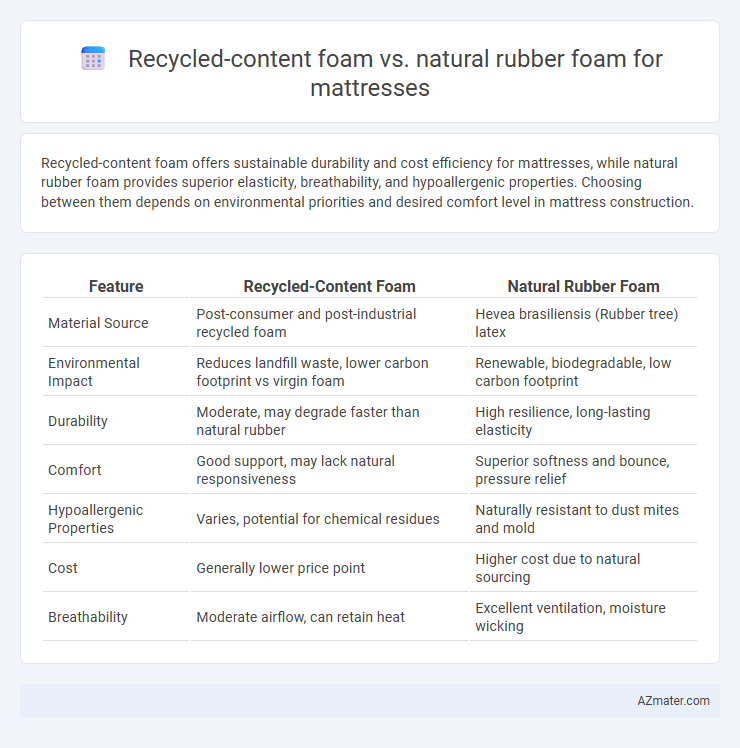Recycled-content foam offers sustainable durability and cost efficiency for mattresses, while natural rubber foam provides superior elasticity, breathability, and hypoallergenic properties. Choosing between them depends on environmental priorities and desired comfort level in mattress construction.
Table of Comparison
| Feature | Recycled-Content Foam | Natural Rubber Foam |
|---|---|---|
| Material Source | Post-consumer and post-industrial recycled foam | Hevea brasiliensis (Rubber tree) latex |
| Environmental Impact | Reduces landfill waste, lower carbon footprint vs virgin foam | Renewable, biodegradable, low carbon footprint |
| Durability | Moderate, may degrade faster than natural rubber | High resilience, long-lasting elasticity |
| Comfort | Good support, may lack natural responsiveness | Superior softness and bounce, pressure relief |
| Hypoallergenic Properties | Varies, potential for chemical residues | Naturally resistant to dust mites and mold |
| Cost | Generally lower price point | Higher cost due to natural sourcing |
| Breathability | Moderate airflow, can retain heat | Excellent ventilation, moisture wicking |
Introduction to Mattress Foam Materials
Recycled-content foam in mattresses offers an eco-friendly alternative by incorporating post-consumer and post-industrial waste, reducing environmental impact without compromising comfort or support. Natural rubber foam, derived from the sap of rubber trees, provides superior elasticity, durability, and breathability, making it a popular choice for organic and hypoallergenic bedding options. Both materials contribute unique benefits to mattress foam technology, influencing factors like resilience, airflow, and sustainability in sleep product design.
What is Recycled-Content Foam?
Recycled-content foam is a sustainable mattress material made by repurposing polyurethane or memory foam scraps, reducing environmental waste and reliance on virgin petroleum-based resources. It offers similar comfort and durability to traditional foam while lowering carbon footprint and landfill contributions. This eco-friendly option supports green manufacturing practices without compromising mattress performance.
What is Natural Rubber Foam?
Natural rubber foam is a sustainably sourced material derived from the latex sap of rubber trees, known for its elasticity, durability, and breathability. It provides superior cushioning and pressure relief compared to recycled-content foam, which consists of processed synthetic or repurposed materials. Due to its biodegradable nature and hypoallergenic properties, natural rubber foam is preferred for eco-friendly and health-conscious mattress designs.
Environmental Impact Comparison
Recycled-content foam reduces landfill waste by repurposing post-consumer materials, lowering the carbon footprint compared to virgin foam production. Natural rubber foam, derived from renewable rubber tree sap, offers biodegradability and minimal chemical use but involves agricultural land use and deforestation concerns. Evaluating overall environmental impact, recycled-content foam excels in waste reduction while natural rubber foam provides a sustainable, biodegradable alternative with potential ecological trade-offs.
Durability and Longevity
Recycled-content foam mattresses offer moderate durability but tend to compress and degrade faster than natural rubber foam, which provides superior resilience and long-lasting support due to its inherent elasticity and resistance to wear. Natural rubber foam resists sagging, retains its shape over time, and typically lasts 8-12 years, outperforming recycled-content foam mattresses that often have shorter lifespans of 5-7 years. The enhanced durability of natural rubber foam minimizes the need for frequent replacement, making it a cost-effective and sustainable choice for long-term mattress use.
Comfort and Support Performance
Recycled-content foam offers consistent support and pressure relief with medium firmness, making it suitable for a wide range of sleepers. Natural rubber foam provides superior responsiveness and durability, maintaining its shape over time while offering excellent cushioning and bounce. Both materials ensure comfort, but natural rubber foam excels in breathability and resilience, enhancing long-term mattress performance.
Health and Allergen Considerations
Recycled-content foam mattresses often contain synthetic chemicals that may off-gas volatile organic compounds (VOCs), potentially triggering allergies or respiratory issues in sensitive individuals. Natural rubber foam, derived from latex sap, is inherently hypoallergenic, resistant to dust mites, mold, and mildew, and less likely to emit harmful VOCs, promoting a healthier sleeping environment. Choosing natural rubber foam can significantly reduce exposure to allergens and improve indoor air quality for allergy-prone sleepers.
Cost Differences and Affordability
Recycled-content foam mattresses generally offer greater affordability due to lower manufacturing costs linked to repurposed materials, making them a budget-friendly option without compromising comfort. Natural rubber foam, derived from renewable latex trees, tends to have higher production expenses, reflecting in increased retail prices but often providing superior durability and hypoallergenic benefits. Consumers seeking cost-effective mattresses often prioritize recycled-content foam, while those valuing natural, eco-friendly materials may invest more in natural rubber foam despite the price difference.
Certifications and Safety Standards
Recycled-content foam and natural rubber foam both comply with stringent certifications and safety standards such as CertiPUR-US for low emissions and the OEKO-TEX Standard 100 for harmful substances, ensuring consumer health protection. Natural rubber foam often carries additional certifications like GOLS (Global Organic Latex Standard) and FSC (Forest Stewardship Council) when sourced sustainably, highlighting its eco-friendly and non-toxic attributes. Recycled-content foam emphasizes sustainability through certifications like GREENGUARD Gold, confirming reduced chemical emissions suitable for indoor air quality.
Choosing the Right Foam for Your Mattress
Recycled-content foam mattresses offer an eco-friendly alternative by utilizing post-consumer plastics while providing medium firmness and effective pressure relief, ideal for budget-conscious and environmentally aware consumers. Natural rubber foam mattresses deliver superior durability, hypoallergenic properties, and excellent breathability, making them suitable for individuals with allergies or those seeking long-lasting, natural materials. Selecting the right foam depends on factors such as comfort preference, environmental impact, allergen sensitivity, and mattress longevity.

Infographic: Recycled-content foam vs Natural rubber foam for Mattress
 azmater.com
azmater.com